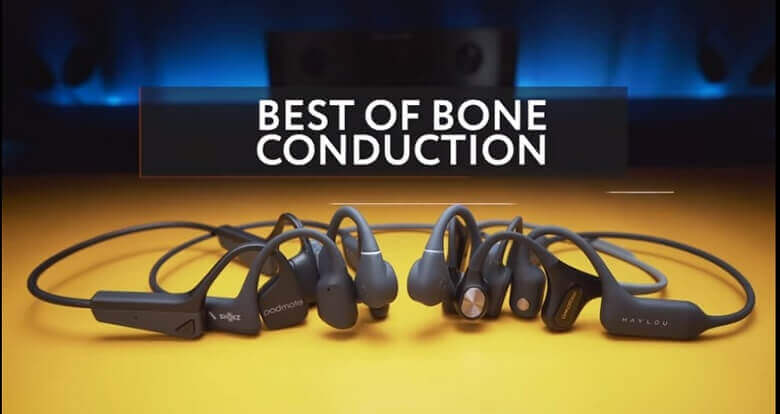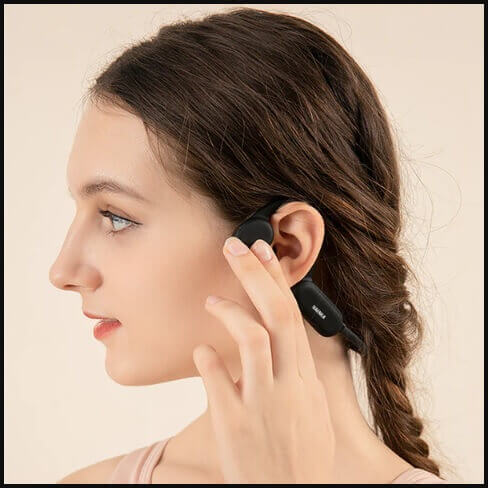There are 3 main bone conduction headphone types that you can buy and use today, and they include:
Sport Bone Conduction Headphones:
These headphones are designed specifically for sports and fitness activities and often have features like water resistance and a secure fit to stay in place during movement.
Examples include Shokz OpenRun Pro and Philips TAA7607.
Swimming Bone Conduction Headphones:
These headphones are designed for use during water activities, with a waterproof design and secure fit to ensure they stay in place during use.
Examples include Shokz OpenSwim and Finis Duo.
Communication Bone Conduction Headphones:
These headphones are designed for hands-free communication and often include features like a boom microphone and noise-canceling technology.
Examples include Shokz OpenComm and Vidonn F3 Pro.
There are other classifications for bone-conduction headphones based on;
- their use of wireless connectivity or wired cords,
- and on the intended field of applications for the bone conduction technology, such as Military, Firefighter and Police, Hearing aid field, Sports, Office Work, Leisure etc.

*** TABLE OF CONTENTS ***
Introduction to Bone Conduction Headphones and Headphone Types
What are bone-conduction headphones?
Bone conduction headphones are a type of headphones that transmit sound to the inner ear through the bones in the skull, rather than through the traditional method of air conduction via ear cups and earbuds.
The sound is generated by tiny vibrations that are sent directly to the cochlea, bypassing the eardrum and outer ear.
How do they work?
Bone conduction headphones work by creating small vibrations that are transmitted to the bones in the skull, which then transmit the sound directly to the inner ear.
This allows the user to hear audio without blocking their ears, which can be especially useful for individuals who need to remain aware of their surroundings, such as athletes, swimmers, or people with hearing impairments.
What are the benefits of using BC headphones?
Bone conduction headphones offer several benefits, including improved safety and awareness, improved comfort, and improved accessibility for individuals with hearing impairments.
By allowing users to hear audio without blocking their ears, they can remain aware of their surroundings and react to potential dangers more quickly.
Additionally, they are often more comfortable than traditional headphones, as they do not press against the ear or cause discomfort after extended use.
There are many benefits to using these bone-conducting headphones, and they include:
- They do not block out ambient noise, which means that you can hear your surroundings while you are listening to music or making phone calls.
- They are ideal for people with hearing impairments or ear conditions, as they bypass the ear canal and deliver sound directly to the cochlea.
- They are comfortable to wear, as they do not put pressure on the ear canal, which can cause discomfort for some people.
- They are water-resistant and sweat-proof, making them ideal for people who are active and need headphones that can keep up with their lifestyles.
Major Bone Conduction Headphone Types
There are 3 major bone-conduction headphone types that are available on the market today. [1]
And they are:
- Sports Bone Conduction Headphones
- Swimming Bone Conduction Headphones
- Communication Bone Conduction Headphones
We will look at the design and structure, features, and functionality of the 3 Bone Conduction Headphone Types below;
Sport Bone Conduction Headphones
Design and Structure
Sports headphones are designed specifically for active individuals who require a secure fit for their headphones during sports and fitness activities.
They feature a sleek, lightweight design that stays in place during movement. The headphones are typically made with water-resistant materials and are built to endure the demands of physical activity.

Features and Functionality
Sport bone headphones are packed with a variety of features to enhance the user’s experience during physical activity.
These features include water resistance, heart rate monitoring, music playback, and voice commands.
The headphones use bone conduction technology to deliver clear audio, so users can hear their music or audio cues without blocking their ears.
Additionally, the headphones have a secure fit to prevent them from slipping or falling off during activity.
Examples
- Shokz OpenRun Pro
The Shokz OpenSwim is a perfect example of sports headphones.
They feature a secure fit, water resistance, and bone conduction technology for clear audio.
The OpenRun Pro boasts impressive audio tech, which makes them the ideal choice for active audiophiles.
- Philips TAA7607
The Philips Go TAA7607 headphones are another example of sports headphones.
They are designed for active individuals who want a secure fit and clear audio while they exercise.
The Philips Go Series A7607 is lightweight, water-resistant, and features bone conduction technology for clear audio.
They also have voice commands, music playback, and a secure fit to prevent them from slipping during activity.
List of Sport Bone Conduction Headphones
Here’s a list and comparison table for Sports Bone Conduction Headphones
Sports Bone Conduction Headphones
Note: factors affecting pricing may vary depending on the retailer, shopping seasons, and location.
Swimming Bone Conduction Headphones
Design and Structure
Swimming headphones are designed for use in the water and feature a waterproof design that can withstand submersion.
They are typically equipped with a secure fit to prevent them from falling off during swims and are built to be lightweight and comfortable for extended use.

Features and Functionality
Swimming bone headphones are specifically designed for listening to music and audio cues underwater.
They use bone conduction technology to deliver clear audio, even in the water.
This technology allows the user to hear the audio without having to insert earbuds or earplugs, ensuring they remain aware of their surroundings while they swim.
The headphones also have a secure fit to prevent them from slipping off during swims.
Examples
- Shokz OpenSwim
The Shokz OpenSwim is a perfect example of swimming headphones.
They feature a secure fit, waterproof design, and bone conduction technology for clear audio.
The OpenSwim comes with a built-in MP3 player, making them an all-in-one solution for swimmers and triathletes alike.
- Finis Duo
The Finis Duo is another good example of swimming headphones.
They are designed with a waterproof design and feature bone conduction technology for clear audio underwater.
The Duo also has a secure fit to prevent them from slipping off during swims.
Additionally, the headphones are lightweight and comfortable for extended use, making them an ideal choice for swimmers.
List of Swimming Bone Conduction Headphones
Here’s a list and comparison table for Swimming Bone Conduction Headphones
Swimming Bone Conduction Headphones
Note: factors affecting pricing may vary depending on the retailer, shopping seasons, and location.
C. Communication Bone Conduction Headphones
Design and Structure
Communication headphones are designed for hands-free communication, making them ideal for outdoor activities, such as biking or running.
They have a compact and lightweight design that can be worn comfortably for extended periods of time.
Communication bone conduction headphones often come with a boom microphone for clear voice transmission.

Features and Functionality
Communication bone headphones use bone conduction technology to deliver clear audio and voice transmission.
The boom microphone allows for hands-free communication, making it easier for the user to remain focused on the task at hand.
Additionally, the headphones have a secure fit to prevent them from slipping off during activities and are often designed to be water-resistant for use in inclement weather.
Examples
- Shokz OpenComm
The Shokz OpenComm is a great example of communication headphones.
It features bone conduction technology for clear audio and voice transmission and comes with a boom microphone for hands-free communication.
The headphones have a secure fit and are water-resistant for use in inclement weather.
Additionally, the Shokz OpenComm is compact and lightweight for comfortable extended use.
- Vidonn F3 Pro
The Vidonn F3 Pro is another example of communication headphones.
It features bone conduction technology and a boom microphone for hands-free communication.
The headphones have a secure fit and are designed to be water-resistant, making them ideal for outdoor activities.
The Vidonn F3 Pro is also compact and lightweight, making it comfortable to wear for extended periods of time.
List of Communication Bone Conduction Headphones
Here’s a list and comparison table of communications bone conduction headphones you
Communication Bone Conduction Headphones
Note: factors affecting pricing may vary depending on the retailer, shopping seasons, and location.
Wired and Wireless Bone Conduction Headphone Types
As with any type of headphone, bone conduction headphones come in different types, with one of the most important classifications being wired and wireless headphones. [2]
Wired bone conduction headphones connect to devices using a physical wire, while wireless bone conduction headphones connect via Bluetooth technology.
Both types have their advantages and disadvantages, making it important to choose the right type based on your specific needs and preferences.
Wired Bone Conduction Headphones

Wired bone conduction headphones are typically more affordable and reliable than their wireless counterparts.
They also tend to be more compatible with a wider range of devices, as they do not require Bluetooth connectivity.
However, the physical wire can be cumbersome and may get tangled or caught during use, especially during physical activities.
Additionally, the wire can limit the range of movement and may pose a safety risk if not properly secured.
Wireless Bone Conduction Headphones

Wireless bone conduction headphones, on the other hand, offer more convenience and flexibility than wired headphones.
They eliminate the need for a physical wire, allowing for greater freedom of movement during use.
They are also generally more compact and easier to carry around than wired headphones.
However, wireless headphones can be more expensive than wired headphones and may require a compatible device with Bluetooth connectivity.
Additionally, they may suffer from connectivity issues or battery life problems, which can be frustrating for users.
Overall, choosing between wired and wireless bone-conduction headphones depends on individual preferences and needs.
Wired headphones are a good option for those who prioritize affordability and reliability, while wireless headphones are better suited for those who value convenience and flexibility.
It is important to carefully consider the features and benefits of each type before making a purchase.
Comparison of Wired vs. Wireless Bone Conduction Headphones
Below is a table comparing the features and functionality of wired and wireless bone-conduction headphones:
In conclusion, whether to choose wired or wireless bone conduction headphones ultimately comes down to individual needs and preferences.
Both types have their advantages and disadvantages, and it is important to carefully consider these factors before making a purchase.
Ultimately, the right type of bone conduction headphones should provide a comfortable, reliable, and high-quality audio experience for the user.
Bone Conduction Headphone Types By Applications
Bone conduction headphones have a wide range of applications across various industries and fields.
They offer unique benefits such as situational awareness, comfort, and accessibility, which make them ideal for use in specific settings.
Classification based on application includes segments such as military, firefighter and police, hearing aid field, sports, office work, leisure, and more. [2]
Military
Military personnel, for instance, can benefit greatly from the use of bone conduction headphones due to their ability to provide audio while allowing the user to remain aware of their surroundings.
This can be particularly useful in combat situations where situational awareness can mean the difference between life and death.
In addition, bone conduction headphones can be used for communication between team members without the need for blocking out external noise, which can be critical in military operations.
Firefighting and Policing
Firefighters and police officers can also benefit from the use of bone conduction headphones.
In high-pressure situations where quick and effective communication is essential, bone conduction headphones can provide a reliable and efficient means of communication.
They can also help to protect the user’s hearing in loud environments such as sirens and explosions.
The Field of Hearing Aids, Rehabilitation, and Special Education Needs

The hearing aid field is another area where bone conduction headphones have made a significant impact.
For individuals with certain types of hearing loss, bone conduction headphones can provide a viable alternative to traditional hearing aids.
They can help to improve hearing without the need for invasive procedures, making them an attractive option for many people.
They are also used by Children and Adults with Speech, Language, and Learning Difficulties, such as those suffering from Speech and language disorders, Learning disabilities, Autistic spectrum disorder, Stroke, Brain Injury Rehabilitation, Dyslexia, ADD and/ or ADHD, and Auditory processing disorder.
When used under the guidance of a professional & complementary to other therapies Forbrain can help with Speech and language disorders, Learning disabilities, Autistic spectrum disorder, Stroke and brain injury rehabilitation, dyslexia, ADD and ADHD, and Auditory processing disorder.
Of which the most common use was for speech issues, reading, language, memory, and focus, and it is often recommended to them by Occupational Therapists, Speech Therapists, and Child Therapists.
Sports
Sports enthusiasts can also benefit from the use of bone conduction headphones.
They can be particularly useful for activities such as running, cycling, and other outdoor activities where situational awareness is important.
By allowing the user to remain aware of their surroundings while still enjoying audio, bone conduction headphones can help to improve safety during exercise.
Office Work
Office workers can benefit from the use of bone conduction headphones for several reasons.
They can help to block out distractions in a busy office environment, allowing for increased focus and productivity.
They can also be useful for conference calls and other forms of communication, providing clear and reliable audio without the need for traditional headphones or speakers.
Leisure
In leisure activities, bone conduction headphones can be used for a wide range of purposes.
From listening to music while swimming to watching movies on a plane without disturbing other passengers, bone conduction headphones offer a convenient and practical solution.
Comparing the Features and Functionality of Bone Conduction Headphones in Different Applications
Below is a table comparing the features and functionality of bone conduction headphones in different applications:
In conclusion, bone conduction headphones offer a versatile and practical solution for a wide range of applications.
From military and police operations to leisure activities and office work, they provide unique benefits such as situational awareness, comfort, and accessibility.
It is important to choose the right type of bone conduction headphones based on your specific needs and preferences, whether it is for sports, swimming, communication, or hearing aid purposes.
Wired and wireless bone conduction headphones also offer different advantages and disadvantages, making it important to carefully consider which type is best for you.
Wired headphones are generally more affordable and reliable, while wireless headphones offer more convenience and flexibility.
As bone conduction technology continues to advance, we can expect to see even more applications and benefits of bone conduction headphones.
From improved sound quality to longer battery life and increased compatibility with a wider range of devices, the future of bone conduction technology is bright.
What are the Differences Between the Types of Bone Conduction Headphones?
The differences among the three main types of bone conduction headphones include:
Sport: These headphones are designed for active use and often have features like water resistance, secure fit, and flexibility to accommodate a variety of sports and fitness activities.
They may also have additional functions like heart rate monitoring, music playback, and voice commands.
Swimming: These headphones are designed specifically for use in water and have waterproof design and secure fit to ensure they stay in place during use.
They may also have additional features like underwater audio playback, bone conduction technology for clear audio, and secure fit to prevent loss during swims.
Communication: These headphones are designed for hands-free communication and often include features like microphone and noise-cancelling technology.
They may also have additional functions like voice commands, music playback, and voice-activated controls.
Each type of bone conduction headphone is designed to meet the specific needs of different activities, so it’s important to consider what you’ll be using them for when choosing a pair.
Table Comparing the Differences in the Design, Key Features, and Ideal Usage of the 3 Main Bone Conduction Headphone Types
Do they work differently from one another?
Sport, Swimming, and Communication Bone Conduction Headphones all work on the same principle of transmitting sound vibrations to the inner ear through the bones in the skull, bypassing the eardrum.
However, each type of bone conduction headphone is designed and built with different features and functionalities to suit different needs and activities.
- Sport
Sport bone headphones are designed to provide a secure fit during physical activity, while also delivering high-quality sound.
They usually come with features such as water resistance, lightweight design, and long battery life, making them ideal for outdoor activities such as running, cycling, or hiking.
- Swimming
Swimming bone headphones are designed for use in water and come with features such as waterproof materials and a secure fit.
These headphones are built to withstand the pressure of water, ensuring that the sound vibrations are transmitted effectively to the inner ear.
- Communication
Communication bone headphones are designed for hands-free communication, making them ideal for a variety of activities.
They come with features such as a boom microphone for clear voice transmission, a secure fit, and noise reduction technology to ensure clear sound transmission in noisy environments.
These headphones are also designed to provide high-quality sound for music and other audio.
Overall, each type of bone conduction headphone is designed with different features and functionalities to suit specific needs and activities, making them work differently from one another.
Bone Conduction Headphone Types Comparison
Sport:
- Designed for active use, with a secure fit and water resistance
- Additional functions like heart rate monitoring, music playback, and voice commands
- Bone conduction technology for clear audio
Swimming:
- Designed for use in water, with a waterproof design and secure fit
- Underwater audio playback and clear audio via bone conduction technology
- Secure fit to prevent loss during swims
Communication:
- Designed for hands-free communication, with microphone and noise-canceling technology
- Voice commands, music playback, and voice-activated controls
- Clear audio via bone conduction technology
Each type of bone-conduction headphone is designed to meet specific needs, so it’s important to consider what you’ll be using them for before choosing a pair.
Compare their Benefits and Advantages
Here’s a table comparing the benefits and advantages of the three main types of bone conduction headphones types:
Table Comparing the Differences in the Design, Key Features, and Ideal Usage of the 3 Main Bone Conduction Headphone Types
Each type of bone conduction headphones offers its own set of benefits and advantages, depending on what you’ll be using them for. It’s important to consider what you need in a pair of headphones before choosing one.
Bone Conduction Headphone Types FAQs
What is the sound quality like on bone conduction headphones?
The sound quality of bone-conduction headphones can vary depending on the model and manufacturer.
Some bone conduction headphones offer high-quality audio, while others may have limitations or compromises in sound quality.
It is important to research and compares different models before making a purchase to ensure that the sound quality meets your needs.
What should I consider when buying bone conduction headphones?
When buying bone-conduction headphones, it is important to consider factors such as design, features, sound quality, battery life, and price.
You should also consider your intended use, such as sports, swimming, or communication, and choose a model that is designed for your specific needs.
How do I clean and maintain my bone conduction headphones?
To clean and maintain your bone-conduction headphones, it is important to follow the manufacturer’s instructions and guidelines.
This may include wiping the headphones down with a damp cloth, avoiding exposure to moisture or extreme temperatures, and storing the headphones in a safe and dry place when not in use.
Regular maintenance and cleaning can help prolong the lifespan of your bone-conduction headphones and ensure that they continue to work as intended.
How does bone conduction technology work compared to traditional headphones?
Traditional headphones use ear cushions or earbuds to deliver sound directly into the ear canal.
On the other hand, bone-conduction headphones vibrate sound waves directly through the bones in the face and skull to the inner ear, bypassing the eardrum.
This allows users to hear audio while also being able to hear their surroundings.
Are bone conduction headphones safe for hearing?
Yes, bone-conduction headphones are generally considered safe for hearing.
However, as with any headphones, it is important to use them in moderation and at a safe volume level to protect against hearing damage.
Can bone conduction headphones be used for all types of activities?
Yes, but different bone conduction headphones are specifically designed for certain activities such as sports, swimming, and communication.
Each type of bone-conduction headphone has unique features and functionality that make it suitable for its intended use.
Are bone-conduction headphones comfortable to wear for extended periods of time?
Comfort level may vary between individuals and depends on the design and structure of the headphones.
Some bone-conduction headphones are designed with adjustable straps and cushioned pads for comfortable all-day wear, while others are designed to be worn during specific activities.
It is recommended to try on the headphones before purchasing to determine your personal comfort level.
Here is a video guide to choosing the best bone conduction headphones by Andy’s Tech Tone.
Conclusion
Recap of Major Bone-Conduction Headphone Types
Bone conduction headphones are a unique type of headphone that transmits sound through the bones in the skull, bypassing the ear canal.
There are three major types of bone conduction headphones: sport, swimming, and communication headphones.
Sport headphones are designed for outdoor activities, such as running and cycling, and often come with features such as water resistance, secure fit, and compact design.
Swimming headphones are designed specifically for swimming, with features such as waterproofing and a secure fit to prevent slipping during swimming.
Communication headphones are designed for hands-free communication, with features such as a boom microphone for clear voice transmission, water-resistance, and a secure fit for activities.
In summary, bone conduction headphones offer a unique and practical solution for a wide range of applications.
Whether you are in the military, working in a busy office, or simply looking for a comfortable and safe way to listen to audio during exercise, bone conduction headphones can provide a convenient and reliable solution.
By understanding the different types and applications of bone conduction headphones, you can make an informed decision and choose the best headphones for your specific needs and preferences.
Final Thoughts and Recommendations
Bone conduction headphones are a great option for those who are looking for a unique listening experience.
They offer several benefits, such as the ability to hear your surroundings, hands-free communication, and the ability to use them while engaging in outdoor activities.
When choosing a pair of bone conduction headphones, consider your needs and what you will be using them for, as well as the features and design of the headphones.
Future Trends in Bone Conduction Headphone Technology
The future of bone conduction headphone technology is exciting, with advancements in design, features, and functionality expected in the coming years.
There is potential for bone conduction headphones to become more compact, with improved battery life and sound quality.
Additionally, there may be a shift towards bone conduction headphones with built-in voice assistants, making them more convenient and easier to use.
With these advancements, bone conduction headphones are poised to become an even more popular and essential device for those who are always on the go.
Further Reading
- “What Are Bone Conduction Headphones? Here Are 7 Things You Should Know” by Jennifer Allen, How-To Geek. [1]
- “How Do Bone Conduction Headphones Work?” by Beebom. [2]
- “THE BEST BONE CONDUCTION HEADPHONES” by AUDIOPHILE ON. [3]
- “Bone conduction: An explanation for this phenomenon comprising complex mechanisms.” by Science Direct. [4]
- “Best bone conduction headphones for 2023” by SoundGuys. [5]
- “Global Bone Conduction Headphones Market By Type (Wired Type , and Wireless Type), By Application (Military , Hearing Aid Field , and Sports ), By Region and Key Companies – Industry Segment Outlook, Market Assessment, Competition Scenario, Trends and Forecast 2022–2031” by Market.us. [6]
- “Bone conduction devices market 2023-2027: A descriptive analysis of five forces model, market dynamics, and segmentation – Technavio” by Yahoo Finance. [7]


